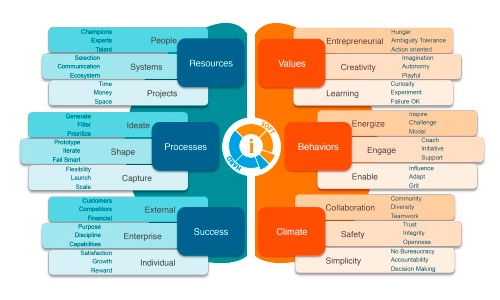Internal vs. external benchmarking in innovation. The Babson / Dícere model

Agustín Ramos, Dícere
Understanding the position in the league is however of no use to help the team or the company to do better. For this, internal benchmarking is more valuable. Understanding in which positions are they strong and in which others are they weak will help them more to find the support in their strengths to improve their weaknesses and aim higher.
In any case, knowing where one is and where one wants to go is the starting point to develop a plan to win, or at least a plan to improve. This is the power of benchmarking.
Innovation is a discipline in development. By definition, if we knew what we were doing, we would not be innovating. If this is so, what is the value of benchmarking if no one knows exactly what the winning plan is?
Despite Innovation not being as well understood as a discipline as Marketing or Chemistry, for example, there are plenty of examples of winning and losing businesses and the way they have been innovative. Professors Rao and Weintraub, from Babson College in Boston have studied hundred of companies and tracked their behaviors and results to develop a single model of their Culture of Innovation. This model granulates the fuzzy concept of culture in six blocks, each one composed of three factors, and each one composed of three elements. The 54 elements allow companies to understand exactly the status of their innovation culture today, their strengths and weaknesses to develop an improvement plan based on them, and measure the progress as the plan gets implemented. Company employees fill in an easy on-line questionnaire rating the 54 elements that results in a static picture of the innovation culture at that specific point of time.

The results serve each company to develop their action plans to improve. Internal benchmarking is possible among hierarchy levels (typically managers are more optimistic than blue-collar workers), functions (typically Marketing or Sales have different perceptions than Production), geographies (global companies may realize they do not have one culture, but several ones). As hundreds of companies in different geographies are currently participating in the questionnaire, external benchmarking will also be possible in the near future, helping to correlate the business results with the specific elements that influence them more. Companies will learn to innovate based on their own experience and in the experience of others.
In net, this model will accelerate the development of Innovation as a Discipline, so that it can be taught and learned much faster. It sounds like good news for businesses to progress in the ever faster changing world-league competitive environment.
Agustín Ramos, Dícere
Versión en castellano:
Compartivas (Benchmarking) internas y externas en innovación. El modelo Babson / Dícere
- On 2 desembre, 2014

